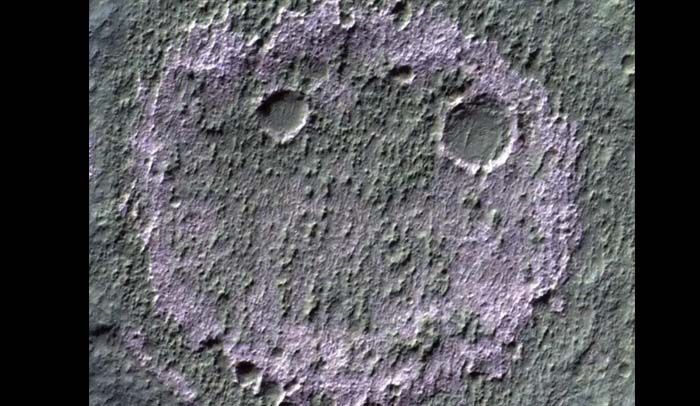Smiley Face on Mars, Astronomers Discover Clue to Ancient Life
Chloride deposits are key indicators of past water activity.

Astronomers have recently discovered what appears to be a smiley face on Mars, and it may hold clues to ancient life on the Red Planet. This fascinating feature was identified during a survey of Mars, as researchers mapped chloride salt deposits using data from the European Space Agency’s (ESA) ExoMars Trace Gas Orbiter. The research team has found 965 such deposits across the Martian landscape, with sizes ranging from 1,000 to 10,000 feet wide. Their findings were published in the journal Scientific Data on August 3.
The smiley face, though intriguing for its resemblance to a human expression, could point to something much more significant: evidence of Mars’ ancient water systems. Chloride deposits are key indicators of past water activity, and scientists believe they were likely formed billions of years ago when liquid water existed on the planet. These deposits are thought to be remnants of evaporated saltwater lakes or streams, which could have provided an environment conducive to microbial life.
Scientists have long been fascinated by the possibility of ancient life on Mars, and this discovery fuels ongoing research. The Martian smiley face may not only be a visual curiosity but also a clue that Mars once had the conditions necessary to sustain life. The research team emphasized that chloride salts often form in areas where water evaporates, similar to salt flats on Earth. Therefore, these deposits could reveal much about Mars’ climate history and its potential for hosting life.
View this post on Instagram
Lead researcher Dr. Janelle Shay, a planetary scientist, highlighted the importance of this discovery. “These chloride deposits are a window into Mars’ past, revealing where water once flowed. The shape we see, although eye-catching, is secondary to the scientific value of these salts. They provide critical clues about Mars’ ancient climate and could help us understand whether life ever existed on the planet.”
The European Space Agency’s ExoMars Trace Gas Orbiter has been instrumental in mapping the surface of Mars and gathering data for scientists to analyze. It orbits Mars and detects the chemical makeup of the planet’s atmosphere and surface, focusing on trace gases such as methane, which could be linked to biological activity. The orbiter’s high-resolution imaging capabilities have allowed researchers to detect the chloride deposits scattered across Mars.
This discovery comes at a time of heightened interest in Mars exploration, with NASA’s Perseverance rover actively searching for signs of past life. The rover is equipped to collect rock and soil samples, which will be returned to Earth on a future mission. If ancient microbial life existed on Mars, scientists believe it might be preserved in these deposits or the rock layers that formed around them.
Though the smiley face may be a quirky coincidence, its underlying geological significance adds to the growing body of evidence that Mars was once a planet with liquid water. While there is no direct evidence of life yet, scientists are hopeful that further study of these chloride deposits could provide more definitive answers.
Mars continues to captivate astronomers with its mysterious features and potential to reveal insights into the early history of the solar system. As exploration efforts advance, discoveries like this smiley face in the Martian desert serve as both a reminder of the planet’s natural beauty and its potential to uncover secrets about life beyond Earth.
Follow us on Google News, Instagram, YouTube, Facebook, Whats App, and TikTok for latest updates.
















